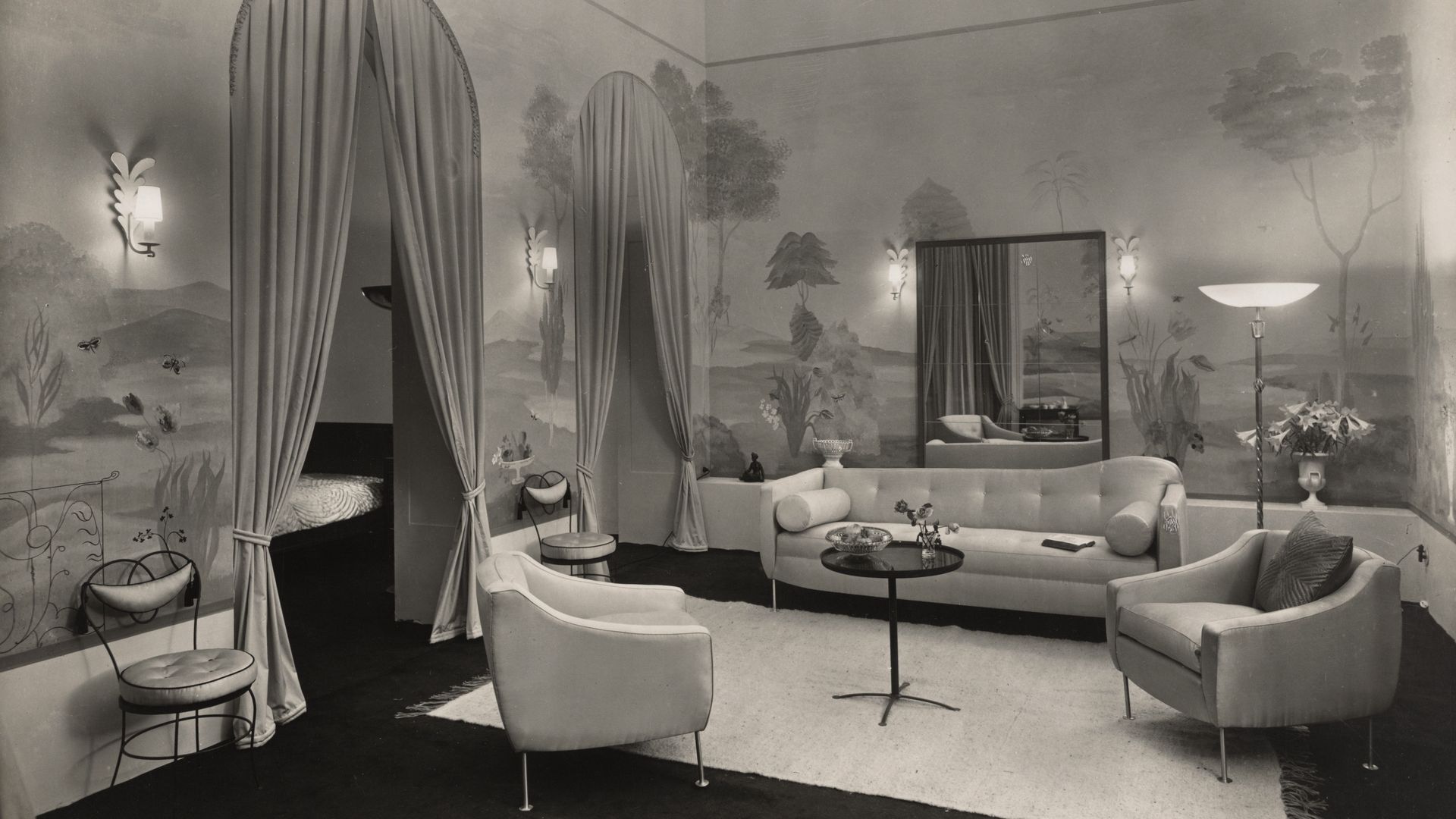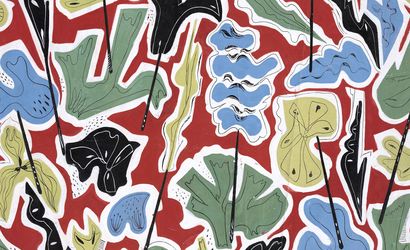Interior designs from the 1920s to the 1950s
Ruth Hildegard Geyer-Raack (1894–1975) was an interior designer, muralist and textile designer whose reputation in the Weimar Republic extended well beyond Berlin. She specialised in high-quality, up-market interior design. With sober elegance, she harmoniously blended modern furnishing styles as antithetical as Bauhaus and art déco. Drawing on the museum’s own holdings, the permanent exhibition at the Berlinische Galerie will, for the first time, display an original fabric produced at the “Vereinigte Werkstätten”, together with 12 selected fabric and wallpaper patterns and 15 photographs of client interiors.
Exhibeted works
In her early works, Ruth Geyer-Raack combined traditional floral motifs with geometric abstraction. As surviving photographs show, her murals covering big walls in private and public interiors were extraordinary for the times. These cheerful imaginative worlds inspired by nature helped to generate a warm, modern ambience quite special in character.
Documentary photographs and the exhibition booklet accompanying the “Internationale Raumausstellung” (IRA) in Cologne in 1931 reflect her career at its peak: alongside celebrated innovative designers of various styles, such as Bruno Paul, Adolf Loos, Le Corbusier and Marcel Breuer, she was the only woman to contribute proposals for a lady’s living room and bedroom.
Selected colour patterns for wallpapers and fabrics from the post-war period show that Geyer-Raack was absorbing contemporary trends without relinquishing her personal, soft, modernist forms. At the Galerie Bremer, a significant cultural hub in West Berlin, she showed black-and-white photographs to document a collection of shelves with distinctive diagonals. She designed simplified patterns of circles, triangles or linear structures to support the fast, value-for-money serial production of fabrics and wallpapers. To ward against cool severity, she interspersed fine curving lines characteristically combined with warm, friendly, low-key shades of colour.
Biography
Ruth Gertrud Hildegard Raack was born on 16 June 1894 at Nordhausen by the Harz Mountains. In 1913 her family moved to Berlin, where she studied painting at a “teaching facility” run by the State Museum of Decorative Arts. This school was headed from 1907 by the architect and furniture designer Bruno Paul (1874–1968), with whom the artist would later collaborate professionally. In 1920/21 she attended courses at the Bauhaus in Weimar.
Two years after her marriage on 2 September 1922 to the government official Hugo Wilhelm Hermann Geyer (1884–1975), she opened her own studio in Berlin under her new name Geyer-Raack. In 1925 she joined the Deutscher Werkbund und in 1928/29 she worked for the Deutsche Werkstätten Hellerau. Until the 1930s she undertook several study trips to Paris, then the heartland of art déco. There she met the Hungarian-born architect André Sivé (born András Szivessy) and at exhibitions she complemented his furniture designs with wall paintings of her own.
Widely known from 1928 thanks to prominent articles in such popular interior design magazines as “Innendekoration”, “Dekorative Kunst” and “Das Ideale Heim”, Geyer-Raack benefited from numerous commissions. She created interiors for country houses, public buildings and passenger liners. She also designed fabrics and wallpapers for companies such as “Deutsche Werkstätten Textilgesellschaft” (DeWeTex), the wallpaper factory “Gebr. Rasch” and “Zimmer & Rohde”. She built a reputation further afield as artistic director of the “Internationale Raumausstellung” in Cologne, where she curated a diverse cross-section of innovative ideas for the home from the avant-garde of international architecture.
As the global depression and mass unemployment took hold, fewer people were able to afford quality interior design. Geyer-Raack's order situation deteriorated. Only a few months after Hitler moved into the Reich Chancellery, she joined the NSDAP on 1 May 1933 and was a member of the National Socialist organisations NS-Frauenschaft, NS-Volkswohlfahrt and Reichskulturkammer. Despite restrictions, she was subsequently able to paint Luftwaffe buildings, for example, and to redecorate rooms in Krakow's Wawel Castle for the National Socialist jurist and war criminal Hans Frank (1900-1946). Geyer-Raack was denazified on 28 September 1948. She worked above all for the booming textile, wallpaper and furniture sectors. However, up until her death in Berlin on 19 March 1975 she was unable to replicate the success she had enjoyed in the years around 1930. Today, the artist’s work can be seen in various prestigious collections, including the Bauhaus Archive in Berlin, the Museum of Decorative Arts in Dresden, the International Design Museum in Munich, the German Wallpaper Museum in Kassel and the Art Institute of Chicago.

